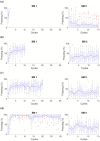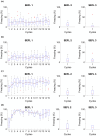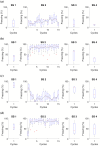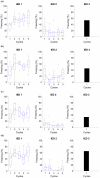Computational modeling of fear and stress responses: validation using consolidated fear and stress protocols
- PMID: 39776892
- PMCID: PMC11703847
- DOI: 10.3389/fnsys.2024.1454336
Computational modeling of fear and stress responses: validation using consolidated fear and stress protocols
Abstract
Dysfunction in fear and stress responses is intrinsically linked to various neurological diseases, including anxiety disorders, depression, and Post-Traumatic Stress Disorder. Previous studies using in vivo models with Immediate-Extinction Deficit (IED) and Stress Enhanced Fear Learning (SEFL) protocols have provided valuable insights into these mechanisms and aided the development of new therapeutic approaches. However, assessing these dysfunctions in animal subjects using IED and SEFL protocols can cause significant pain and suffering. To advance the understanding of fear and stress, this study presents a biologically and behaviorally plausible computational architecture that integrates several subregions of key brain structures, such as the amygdala, hippocampus, and medial prefrontal cortex. Additionally, the model incorporates stress hormone curves and employs spiking neural networks with conductance-based integrate-and-fire neurons. The proposed approach was validated using the well-established Contextual Fear Conditioning paradigm and subsequently tested with IED and SEFL protocols. The results confirmed that higher intensity aversive stimuli result in more robust and persistent fear memories, making extinction more challenging. They also underscore the importance of the timing of extinction and the significant influence of stress. To our knowledge, this is the first instance of computational modeling being applied to IED and SEFL protocols. This study validates our computational model's complexity and biological realism in analyzing responses to fear and stress through fear conditioning, IED, and SEFL protocols. Rather than providing new biological insights, the primary contribution of this work lies in its methodological innovation, demonstrating that complex, biologically plausible neural architectures can effectively replicate established findings in fear and stress research. By simulating protocols typically conducted in vivo-often involving significant pain and suffering-in an insilico environment, our model offers a promising tool for studying fear-related mechanisms. These findings support the potential of computational models to reduce the reliance on animal testing while setting the stage for new therapeutic approaches.
Keywords: Immediate Extinction Deficit (IED); biologically plausible models; computational modeling; contextual fear conditioning; fear extinction; neural architecture; stress models; stress-enhanced fear learning (SEFL).
Copyright © 2024 Furriel, Furriel, Cunha Xavier Pinto and Lemos.
Conflict of interest statement
The authors declare that the research was conducted in the absence of any commercial or financial relationships that could be construed as a potential conflict of interest.
Figures







Similar articles
-
Stress-enhanced fear learning in rats is resistant to the effects of immediate massed extinction.Stress. 2012 Nov;15(6):627-36. doi: 10.3109/10253890.2011.650251. Epub 2012 Jan 24. Stress. 2012. PMID: 22176467 Free PMC article.
-
Know thy SEFL: Fear sensitization and its relevance to stressor-related disorders.Neurosci Biobehav Rev. 2022 Nov;142:104884. doi: 10.1016/j.neubiorev.2022.104884. Epub 2022 Sep 26. Neurosci Biobehav Rev. 2022. PMID: 36174795 Free PMC article. Review.
-
Stress-enhanced fear learning can be reduced with unconditional stimulus deflation with constraints.Behav Brain Res. 2025 Mar 12;481:115438. doi: 10.1016/j.bbr.2025.115438. Epub 2025 Jan 17. Behav Brain Res. 2025. PMID: 39828087
-
Susceptibility and Resilience to Posttraumatic Stress Disorder-like Behaviors in Inbred Mice.Biol Psychiatry. 2017 Dec 15;82(12):924-933. doi: 10.1016/j.biopsych.2017.06.030. Epub 2017 Jul 8. Biol Psychiatry. 2017. PMID: 28778658 Free PMC article.
-
Unrelenting Fear Under Stress: Neural Circuits and Mechanisms for the Immediate Extinction Deficit.Front Syst Neurosci. 2022 Apr 19;16:888461. doi: 10.3389/fnsys.2022.888461. eCollection 2022. Front Syst Neurosci. 2022. PMID: 35520882 Free PMC article. Review.
Cited by
-
The Involvement of the Endocannabinoid, Glutamatergic, and GABAergic Systems in PTSD.Int J Mol Sci. 2025 Jun 20;26(13):5929. doi: 10.3390/ijms26135929. Int J Mol Sci. 2025. PMID: 40649707 Free PMC article. Review.
References
-
- Bennett M., Lagopoulos J. (2018). Stress, Trauma and Synaptic Plasticity. Cham: Springer. 10.1007/978-3-319-91116-8 - DOI
LinkOut - more resources
Full Text Sources

